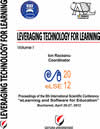E-BOOK, MODERN FORM OF DOCUMENT STORAGE AND COMMUNICATION
E-BOOK, MODERN FORM OF DOCUMENT STORAGE AND COMMUNICATION
Author(s): Ionica Șerban, Mihai SerbanSubject(s): Education
Published by: Carol I National Defence University Publishing House
Keywords: e-books; communication; document storage
Summary/Abstract: Undoubtedly writing contributed to the perception of history from other perspectives. Starting from clay tablets from Summer or Tartaria and until so known editing programs for today’s format text , the writing was obviously the most important form of communication of ideas, concepts and theories. One of the most popular concepts to which we refer when we refer to writing, is the book. Books were for centuries the only means of passing on information, regardless of their(religious, scientific, etc..), reflecting their technological evolution of humankind. Therefore, long time, books were written by hand, and then they have multiplied copyists. But the invention of printing (in Europe around 1450, China and Korea it was known long before), the flow of information has been simplified and books have become an accessible element for public, more than hitherto. There was a long pause in the evolution of the concept book that has remained virtually unchanged, despite the fact that printing technology has changed radically. The so-called break ended a few years ago, because books have entered in a new stage of development -the electronic book or eBook. This is the digital version of a work (either already existing in print or broadcast only in digital format) the version whose content can be viewed either through a computer or through other devices that allow the compatibilization of the systems. Several centuries the printing on led to accelerating evolution of the process of social development. This required a rapid and massive development of paper-making industry which led to the emergence and overcome of serious environmental problems. In efforts to replace paper, the technique successfully identified substitutes: radio, television, teletext, fax, computers, Internet, magnetic or optical supports, microfilms and photographs.
Journal: Conference proceedings of »eLearning and Software for Education« (eLSE)
- Issue Year: 8/2012
- Issue No: 01
- Page Range: 556-560
- Page Count: 5
- Language: English

